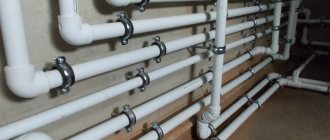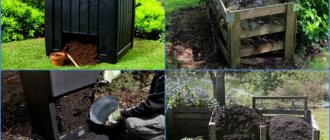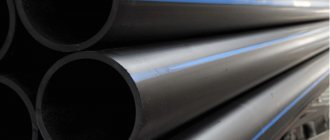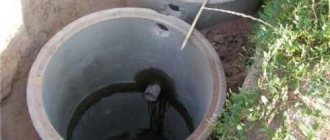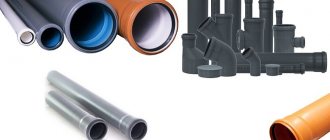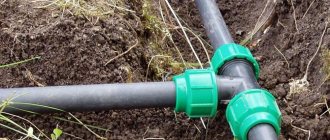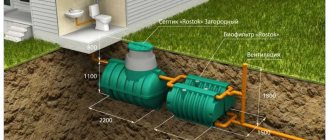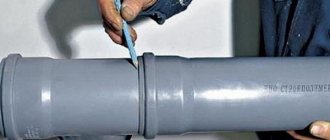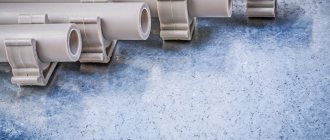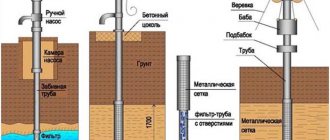Thermoplastic propylene polymers, compared to traditional polyethylene, have a lower density, as well as higher hardness, heat resistance and resistance to corrosive changes. Welding of polypropylene pipes ensures the most reliable connection of all elements into a single system. Such work must be carried out using special equipment, in strict adherence to technology. Let's take a closer look at the intricacies of soldering PPR pipes.
Types of polypropylene pipes
The service life of products depends on the temperature of the environment and the pressure created in them.
With the right choice of material type, it is possible to significantly extend its operational capabilities. There are 4 types of pipe materials that have different characteristics depending on their operating temperature.
| Product type and corresponding markings | Purpose | Ambient temperature, C | Working pressure, MPa |
| PN10 | For cold water supply and heated floors | 20 for cold water supply, 45 for floor heating system | 1 |
| PN16 | For cold and hot water supply | Up to 60 | 1,6 |
| PN20 | For hot water supply | Up to 80 | 2 |
| PN25 | For central heating systems, reinforced products, hot water systems | Up to 95 | 2,5 |
PN10 grade materials refer to products intended for cold water supply. They are not able to withstand high ambient temperatures. The second type, marked PN16, refers to mixed-type products and is intended for cold and hot water supply, but with limited operating temperature. PN20 and PN25 are materials intended for hot water supply. Such pipelines are able to withstand high temperatures, and products marked PN25 are additionally reinforced with metal, which increases their service life and ability to withstand high pressure and temperature conditions.
How to prepare pipes
We cut the pipe at 90 degrees
Having measured the required section of the pipe, a mark is made with a marker. Then, using a pipe cutter or scissors, which should be positioned strictly perpendicular to the pipe being cut, the required part of the product is cut off.
Particular attention should be paid to the quality and sharpness of the cutting tool. If it's not sharp enough, you'll be crushing the pipe instead of cutting it.
Cleaning the edges of the pipe
Since the reinforced pipe contains an aluminum layer, it is necessary to get rid of it. The fact is that over time, aluminum foil will begin to deteriorate from contact with water. To do this, use a stripping device to remove the top and foil layers.
For elements without a reinforcing aluminum layer, mark the welding depth at the end of the pipe, depending on the length of the couplings.
Then you should degrease the welding areas using alcohol-containing liquids. This will make the connection more reliable and durable.
In this case, you should carefully inspect the surface of the pipes being welded. Any tiny particle that gets into a seam can ruin not only this joint, but the entire system.
Pipe welding kit
If welding of polypropylene products has to be carried out regularly, then it is advisable to purchase a special welding kit, which is immediately sold in an appropriate suitcase. Its average cost is about one hundred dollars, and it consists of:
- heating element;
- Teflon nozzles of different sizes;
- scissors for cutting polypropylene pipes;
- bolts that secure the nozzle to the heating element;
- level;
- supports for the heating element;
- hexagon for tightening bolts.
In the case when welding work is carried out occasionally, it is more rational to rent welding equipment.
Welders
From a design point of view, soldering equipment is a bit like a regular electric iron. The base is represented by a massive metal heater, the surface of which is removable special attachments.
Devices for butt welding of polypropylene pipes have more complex designs. In addition to the heating element, they also contain a system responsible for centering the elements being welded.
The classification of equipment for welding plastic pipes divides devices into the following main groups:
- non-professional hand-held devices, or “irons” for soldering PPR pipes. The optimal choice for domestic use (D no more than 50 mm). If necessary, nozzles are used that have a Teflon surface and make it easy to work with larger pipes;
- mechanical welding machines. This technique ensures reliable welding of large pipes with a diameter of 40 mm or more. The design includes additional elements in the form of an instrument block and a frame-based hydraulic unit. On the side parts there are special semi-ring grips with inserts.
The characteristics of additional accessories and their quantity depend on the manufacturer, and are also focused on specific model features of the welding machine.
Types and purpose
Polypropylene pipes can be of four colors - green, gray, white and black. Only black ones differ in their characteristics - they have increased resistance to ultraviolet radiation and are used when laying an irrigation system on the ground. All others have similar characteristics and are laid indoors or buried in the ground.
According to their intended purpose, polypropylene pipes are of the following types:
- For cold water (temperature up to +45°C). They can be easily distinguished by their longitudinal blue stripe.
- For hot water supply (heating up to +85°C). A distinctive feature is a red stripe.
- Universal (maximum heating up to +65-75°C depending on the manufacturer). Two stripes are applied side by side - blue and red.
There are pipes with different characteristics for both cold and hot water. This is displayed in the markings:
- PN10 are used exclusively in cold water supply systems (up to +45°C) with low pressure (up to 1 MPa). They have small wall thickness. Not suitable for high-rise buildings.
- PN16. They are often labeled as universal, but are more often used for cold water - they can withstand heating of the environment up to +65°C and pressure up to 1.6 MPa.
- PN20. Thick-walled pipes, which can transport media with temperatures up to +80°C, can withstand pressures of up to 2 MPa. Used for distributing hot water and heating systems.
- PN25. These are reinforced polypropylene pipes (with foil or fiberglass). Due to the presence of a reinforcing layer, they often have a smaller wall thickness than PN20. The heating temperature of the medium is up to +95°C, pressure is up to 2.5 MPa. Used for hot water supply and heating.
All of them are produced in different diameters - up to 600 mm, but in apartments and private houses they are used mainly in sizes from 16 mm to 110 mm
Please note that the internal diameter is indicated, as wall thickness may vary.
How to properly solder polypropylene - instructions
You need to act consistently, in this case the likelihood that a mistake will be made is reduced.
Step-by-step instructions for soldering polypropylene pipes Soldering instructions:
- Preparing the room. Considering that toxic substances are released during soldering, effective air circulation should be ensured.
- After cutting, the edges of the communications are processed with a trimmer or chamfer. They make chamfers, this makes it easier to join the pipes.
- The materials are degreased: cleaned of dust, treated with white spirit. You need to continue working when the surface is completely dry.
- Turn on the soldering iron, having previously set the temperature to the required level (+260°C).
- When the green light on the body of the soldering iron lights up, you can proceed to soldering. A pipe is installed in the sleeve nozzle, and a fitting is placed on the mandrel.
- At the same time, 2 elements of the future pipeline are heated: a fitting, a pipe.
- After waiting the time indicated in the table above, the pipe and the shaped element are removed from the nozzles and joined to each other. In this case, the parts must be held motionless. Communications are connected to a previously drawn longitudinal line. The slightest displacement of polypropylene that has not yet hardened will lead to the destruction of molecular bonds. This may cause a leak in the future.
Soldering table for polypropylene pipes
| Pipe diameter, mm | Length of the section that is heated, mm | Soldering period duration, seconds | ||
| Holding the pipe in the soldering iron nozzle | When connecting pipeline sections | When polypropylene hardens | ||
| 16 | 12 | 4-5 | 4 | 120 |
| 20 | 14 | 5 | ||
| 25 | 15 | 6-7 | 6 | |
| 32 | 16 | 8 | 240 | |
| 40 | 18 | 10-12 | ||
| 50 | 20 | 18 | ||
The heating and holding time of PP pipes at a given soldering iron temperature allows us to ensure high quality seam joints. Low heating will not allow softening of communications. In this case, it will be impossible to join the pipes.
Connecting pipes by soldering with reinforcement
The operating temperature of communications for cold water supply varies within -10…+90°C. Under the influence of the coolant, the pipeline bends, as intense linear expansion occurs. This means that for heating you need to use pipes that have more suitable characteristics.
1 - cut off the required length of pipe. 2 - remove the reinforcement with a seamstress. 3 - direction marking. 4 - heating of the pipe and fitting. 5, 6 - connecting the pipe with the fitting and fixing it.
Thus, in conditions of exposure to high temperatures, products reinforced with fiberglass or aluminum are used. Such pipes are multilayer products: a thin layer of fiberglass is applied on top of the polymer product and covered with a layer of PP. Advantages:
- relative stability of linear expansion, even under the influence of high temperatures the geometry of the product changes slightly;
- ability to withstand pressure up to 10 atm; for comparison, in apartment buildings, communications are subject to less intense influence (6-8 atm);
- due to the presence of a reinforcement layer, the service life of the pipeline increases;
- pipes with internal reinforcement are resistant to high temperatures, at which the classic version of communications begins to melt.
The technology for soldering reinforced pipes does not differ from the method of joining unreinforced communications, with the only exception: at the preparatory stage, the ends of the products must be cleaned of the reinforcing layer, for which a trimmer or shaver is used. After preparation, the pipes are degreased, then heated with a soldering iron and connected.
Rules for soldering PCB to avoid mistakes
- The diameter of the polypropylene pipe is selected according to the size table;
- before work, prepare everything necessary, since welding is performed quickly, there will be no time for preparation during the installation process, the soldering iron is turned on when the communications are already cut;
- the welding machine must be securely fixed on a horizontal surface, the quality of the seam will depend on this, such units are equipped with special stands, but some models are not installed firmly, so they need to be additionally secured;
- the melting temperature of polypropylene is much lower than the value set in the welding machine settings, this difference is due to the need to quickly soften the pipe; a temperature of +260°C is considered sufficient;
- You should not change the temperature regime when using larger products, when soldering PP pipes, the heating temperature does not change with increasing diameter of communications, from the table above you can find out that the dimensions of the products only determine the duration of heating of the material;
- you need to navigate by the indication: a red light indicates that the heating element has turned on, a green light indicates that the set temperature value has been reached;
- Often users skip the stage of degreasing the material, however, the presence of dust or drops of water in the cut area can cause the seam to weaken, since in this case the structure of the material becomes more porous;
- when installing a pipeline of complex configuration, it is necessary to connect the pipes at different angles, they are also rotated relative to each other; in order not to disturb the alignment of the products, it is recommended to first determine the exact position of the communications, then perform their preliminary installation (without using a soldering iron), at this stage you need to draw a marking strip along the center line through the 2 parts being connected.
It should be taken into account that thin-walled pipes warm up faster. This means that the period of operation of the soldering iron is reduced by 2 times. If you are studying the question at what temperature to solder such pipes, you need to remember that the value of this parameter does not depend on the dimensions of the product. Thin-walled communications are connected to each other at the same temperature as thick-walled ones.
Impact of errors on welding quality
This is what happens if you solder PP pipes incorrectly!
The most common violations of the soldering process:
- surfaces are not degreased, resulting in a decrease in the quality of the seam joint;
- The cut angle of the pipe and fitting does not correspond to 90°;
- insufficient deepening of the pipe into the fitting or, conversely, communications are brought into the shaped element all the way, as a result, a large seam is formed inside, which impedes the flow of liquid;
- violation of the heating technology: the pipes were on the nozzles for too little or, conversely, a lot of time, in both cases the quality of the seam joint will be low;
- when connecting reinforced pipes, the reinforcement layer at the end section was not completely removed, as a result, this material will prevent the melting of polypropylene, such a seam will be weak, or it will not be possible to complete it at all;
- after joining, the position of the parts was adjusted, which led to a decrease in the reliability of the seam; To avoid such consequences, you should wait a while after connecting the pipe and fitting, ensuring that the parts do not move.
How to solder PP pipes without a soldering iron
When considering methods for welding polypropylene pipes, it is not always possible to use a special soldering iron. In this case, choose other options, among them:
- gas-burner;
- compression coupling;
- cold welding.
The gas burner method is less preferable.
If a torch is used, it will not be possible to heat the polypropylene evenly. As a result, the seam joint will look sloppy, in which case the reliability of the seam is reduced. Over time, a leak may appear in this area. This method can be used as a last resort and only when installing cold water supply systems.
Connecting a pp pipe with a compression coupling
The compression coupling provides a reliable connection of communications and is used as a complete replacement for a welding machine. However, the cost of such an element is high. As a result, costs will increase, since a large number of compression fittings will be needed to distribute pipes throughout the room.
Method for gluing polypropylene pipes.
The cold welding method is also effective. In this case, a two-component epoxy composition is used. This material allows you to obtain a reliable connection without special equipment.
To fix the communications, you need to apply an adhesive substance to the cleaned and degreased surfaces of the products. Then the pipe and fitting are joined, holding tightly. The glue sets within 10 minutes. It takes 1 hour to completely harden. This option can only be used when installing a cold water supply system.
Stage two. Welding of polypropylene pipes
This procedure will require an electric jigsaw (cutting polypropylene) and special welding equipment.
Step one. While the apparatus is warming up, the necessary measurements are taken, the pipes are marked and cut.
Step two. The ends of the products that are planned to be connected to each other are thoroughly cleaned and degreased.
Step three. Using a pencil, mark the depth of insertion of each product into the sleeve. It is typical that at least a millimeter gap should remain, so the pipes do not rest against the fitting coupling.
Step four. The PP pipe with fitting is put on the sleeve in accordance with the marks made, and heating of all elements must occur simultaneously.
The heating duration depends not only on the diameter of the products, but also on the depth of welding (this can be found in the table below).
Step five. After a certain period of time, the products are removed and connected, pressing onto each other with little effort. It is prohibited to rotate the elements along the center line.
Step six. Within a few seconds after the connection, an initial adjustment is made, then the elements are finally fixed.
If there are no gaps left at the connection point, then it (the connection) can be considered high quality.
Manufacturing of welding machine
Due to the fact that a more or less good one costs over a thousand rubles, it is cheaper to rent it or make it yourself. If the latter was chosen, then for work you should prepare:
The sequence of actions should be as follows.
Step one. In order to improve heat transfer, the sole of the iron is treated with thermal paste, then a Teflon sleeve is fixed. The location of the latter is determined in advance - the wide part up or down.
Step two. The sharp “nose” is filed off for more convenient work near walls.
Step three. The iron is heated until the device turns off a second time.
Step four. It’s good if the iron is equipped with a temperature sensor - this will allow you to accurately determine the heating temperature. But there is an easier way - through lead. This metal melts at 230ᵒC and above, which approximately coincides with the temperature required for welding.
The further technology is identical to that described above.
Mistakes when soldering plastic pipes
An inexperienced plumber or owner who decides to carry out the installation of a polypropylene water line with his own hands often makes mistakes, not fully knowing the technology of pipe soldering and not knowing how to work with a soldering iron.
The most common errors include the following.
Rice. 8 Differences between budget and expensive irons
Wrong choice of soldering iron
The most popular and inexpensive devices for soldering are electric couplings with attachments for different diameters of PPR. When purchasing and using, you must consider the following factors:
- You need to purchase the device with a convenient holder so that you can easily and quickly install it in place when working independently. This will reduce the time that heated elements are in an undocked state, which can lead to cold welding and further depressurization.
- It is also better to choose the units used with the regulator and power buttons placed in such a way that you do not touch them with your hand during operation, thereby lowering the temperature or turning off the heating.
- If the device is used for regular use, it is better to purchase an expensive model with high-quality Teflon nozzles - this will prevent polypropylene from sticking and improve the quality of connections.
Rice. 9 PPR heating table
- Modern devices are produced with electronic indicators that maintain a constant temperature using a built-in processor, which is reflected on its display. This factor also helps to improve the quality of soldering, the time of which is determined based on the degree of heating of the couplings, which cannot be determined on old-style units.
- The device must maintain a given temperature, which increases with increasing pipe diameter. Many Chinese irons have high temperature parameters, which should be taken into account when choosing a manufacturer; Turkish-made models are considered to be some of the best units in terms of price and quality ratio.
- The shape of the iron and the location of the couplings play an important role in cases where polypropylene pipes are welded in hard-to-reach places. A narrower iron and placement of the couplings on the edge of the pointed end in this case are much more convenient to use.
Repay
Overexposure of elements in the soldering iron for more than the required time leads to their surface overheating and after connection, accompanied by excessive force, the pipe passage becomes clogged with molten plastic. If such an error occurs at a large number of joints of heating or water pipelines, the system will not be able to function normally. In order to avoid this situation, you should strictly follow the time intervals specified in the instructions for each type and diameter of pipes and carry out several test solderings of small sections.
Rice. 10 PPR soldering defects
Low heating, incorrect angle and other errors
Many beginners make a fairly large number of mistakes, which include the following:
- Soldering of dirty elements near the walls or with water remaining in the line, while due to dirt or water cooling, the plastic does not connect well and subsequently depressurization of the joint occurs.
- Insufficient deepening of pipes into sockets of larger diameter. It often occurs when there is a minor error in the installation of faucets - if its valve is not turned at a small angle, the air in the joined area will not have an outlet, preventing the mounted area from being completely immersed in the hole.
- If the elements being connected are not heated sufficiently, the plastic will not have a uniform structure and the joint will depressurize. This defect can be identified by the absence of a skirt at the edge of fittings with a large diameter.
- When manually joining elements, a single axis must be maintained - otherwise distortions will lead to insufficient density and depressurization.
- Also, after joining, the joined area should be kept motionless for a certain time until it cools completely.
Rice. 11 Method of repairing polypropylene pipes by heating the surface of the pipe being repaired with a nozzle
For high-quality soldering in hard-to-reach places, a high-quality choice of soldering iron is of great importance - the model should provide easy access and the required heating temperature without sticking of the PPR. For convenience, all work is divided into two stages - first, long chains are installed in a convenient place, and then they move to the walls, joining sections in weight.
Required Tools
Fitting;
The polypropylene pipes themselves;
A special apparatus for welding such pipes;
Welding machine
A hacksaw for cutting them, a special cutter is often sold complete with a welding machine; for large volumes of work, you can use a ring cutter or special scissors;
Degreaser (ethyl or isobutyl alcohol); It is prohibited to use acetone in this case, as it can soften the plastic;
Chamfer: its internal part resembles a pencil sharpener, however, since the chamfer must be removed smoothly, the knives are located at a different angle; You can replace the bevel remover with a regular file and knife;
Beveler for plastic pipes
Shaver: a tool for removing the reinforced layer (if our pipes have a reinforcement layer).
Shaver
Advice.
Pipes that come close to the heating boiler (at a distance closer than half a meter) should be made only of metal. They are connected to polypropylene using adapters from a welded connection to a threaded one.
Working with polypropylene pipes
Today's polypropylene pipe installation system includes all the necessary elements for connecting pipes of all sizes, contours, fittings, fastenings and inclusions. The assembly process is quite simple and, if you have the necessary skills, happens quickly.
The set of elements can be selected the way you want, so the result is a completely unique system. The complexity and configuration depends only on the preferences and wishes of the customer, that is, you. The only feature that some attribute to the disadvantages of polypropylene is the welded connection method. After welding, it is no longer possible to separate the pipes and correct the error. Therefore, you need to think through everything in advance and try to avoid inaccuracies in actions.
If you break down the pipe welding process into separate steps, it will look like this:
- Using a soldering iron for polypropylene, you need to heat both parts that you want to attach to each other.
- Then you need to connect the heated parts;
- After a short period of time, remove the elements already fastened together from the device.
Welding provides the elements with such a strong connection that it is almost impossible to separate the parts without breaking them. That is why polypropylene pipes are considered high quality, durable and able to withstand almost any pressure.
Polypropylene: features of the material for pipelines
Soldering polypropylene pipe
The use of pipes made of polymer materials for organizing cold or hot water pipelines, as well as heating, is due to a number of qualities of plastics and products made from them. A common material for plumbing – polypropylene (PP) – has a number of advantages:
- temperature/pressure characteristics
- Lightweight compared to metal pipes; no corrosion
- possibility of adding a reinforcing layer
- increasing thermal resistance and maximum fluid flow pressure
- a simple method of connecting to each other, as well as to metal pipes and plumbing fixtures; cost
There is a wide range of fittings and fasteners on the market that allow you to organize a plumbing or heating system with turns, branches or connections with products made from other materials.
Elements of polymer pipelines
When deciding to use polypropylene products for indoor wiring, you should remember the characteristics of the material:
- PP pipes cannot be bent; a connecting element must be welded at each turn of the line
- thin products can be deformed at high temperatures (above +95C), you should carefully study the markings and technical specifications
- When exposed to direct sunlight, the polymer changes color (turns yellow)
- the product may crack from mechanical impact (hitting with a hammer or falling a heavy object)
In addition to pipes made of polymer material without additives, there are reinforced pipes on the market that have increased strength.
At a liquid temperature of more than +95C and a pressure of 20 atm, the lifespan of a PP pipe is significantly reduced.
Reinforced PP pipes
Reinforced polypropylene pipes in cut
To increase the strength of polypropylene products, a thin layer of reinforcing materials is added to them. The purpose of the reinforcement is to reduce linear expansion and deformation during hot water service. For strengthening use:
- Aluminum foil
- Fiberglass
The reinforcing layer can be located outside or between layers of plastic
An important feature of an aluminum-reinforced product is the risk of corrosion of the reinforcing layer if it is not cleaned during the welding process and comes into contact with hot liquid. To solder such pipes, pre-treatment is used, in which a layer of foil is cut off
Making a greenhouse with your own hands from a profile pipe and polycarbonate: a complete description of the process, drawings with dimensions, watering and heating (Photo & Video)
Main stages of work
1. Take a pipe of the required size.
2. We clean its edges from burrs formed during cutting with a file or chamfer.
3. With a pencil, mark at the end of the pipe (see photo) which section we need to melt, that is, we mark the place where the fitting will be put on.
We mark the place of adhesion with a pencil
4. Treat the pipe and fitting with a degreasing compound.
5. Firmly fix the welding machine to the table.
6. Its kit includes nozzles of different diameters. We take the required nozzles (one for the fitting and one for the pipe) and attach them to both sides of the device.
7. Set the temperature to 260°.
8. As soon as the lights go out (this means that the device is warm enough), you can start working. The average heating time is 2-3 minutes.
9. We put a fitting and a pipe on the hot nozzles (there are two of them) up to the pencil mark. Do not put too much pressure on the parts to be welded or rotate them.
Butt welding machine. The fitting and pipe are put on the hot nozzles
10. We count down the required amount of time. The heating time is always indicated in the instructions. For example, for a 25 mm pipe it is exactly 7 seconds).
The heating time of the device depends on the diameter of the pipe
11. Quickly and carefully remove the heated parts, slightly holding the welding machine.
12. Connect them with each other. Excessive pressure on them or rotation is also unacceptable.
13. We wait a few seconds.
14. If we did everything correctly, we get a perfectly smooth, homogeneous connection.
The reinforced layer on a section of the connection must be removed, otherwise the connection will be heterogeneous and fragile;
When purchasing a device, it is not necessary to spend extra money and purchase a model with a thermostat, because we will need only one temperature setting of 260°C; using other modes may result in a poor connection;
Water must flow through the pipes freely; To prevent an obstacle in the form of frozen plastic from forming at the welding site, you should not put too much pressure on the molten parts when joining; however, weak pressure is also unacceptable - the length of the connection for reliable fastening will not be enough; this can lead to the formation of vortex and pressure drop in the system;
The basic rule for such soldering is that the fitting is put on the nozzle first, and only then the pipe; The countdown begins when both parts are on the device;
Polypropylene sets in 4-8 seconds, but you shouldn’t let it go right away - for it to completely harden, you need to wait 20-30 seconds;
When cooling, the parts must remain motionless; the slightest shift can break the tightness of the connection; therefore, before starting soldering, it is better to prepare special clamps for fixing them; they can be made from any block of wood or strong wire;
Cooling the resulting assembly with water or a stream of cold air is prohibited - the connection will be fragile;
Do not heat the pipe and fitting for more than the prescribed time - the polypropylene will be deformed; with less time for heating, the connection of parts will be difficult;
If welded correctly, part of the plastic should form a slight overhang on the coupling;
You can check the quality of your work by cutting the connected section in half; you should see an even monolithic connection without deformations or voids at the junction.
Soldering methods
In practice today, a couple of basic methods are used to ensure durable and reliable joining of welded elements:
- coupling;
- straight.
The first option is welding polypropylene pipelines using a shaped product (coupling) or a pipe having a sufficient external size. This method is suitable for plastic pipelines of small diameter. It consists of melting the outer side of the elements and the inner part of the coupling, which ensures a guaranteed tight joint.
Direct welding involves melting the end part of plastic pipes with the same diameter, as well as their subsequent joining with the end surfaces. A special feature of the method is the need to perform welding with extreme precision in processing all abutting areas and connecting them to each other.
In addition to the “hot” technologies already listed above, you can use a fairly simple and affordable method of “cold” soldering of polypropylene. In this case, a replacement for the active soldering component is a special solvent that promotes rapid softening of the polypropylene structure.
Sewage system made of PP pipes
As noted earlier, polypropylene pipes are now actively used in the construction of buildings. The installation procedure in this case has its own nuances.
Internal sewerage
There are a number of rules that must be followed when installing sewerage in the house.
- The pipeline is laid at an angle in the direction of the sewer riser (about 3 cm per linear meter).
- If the room is not heated, then the pipes are additionally insulated with mineral wool.
- You cannot make sharp turns at an angle of 90ᵒ; instead, so-called half-bends are used.
- Fan-type ventilation is an essential component of the sewer system, which will prevent the penetration of unpleasant odors into the home.
- The toilet is connected only after the sink, otherwise the water seal will break.
External sewerage
Step one. The diameter of the pipes is determined, depending mainly on the number of people living in the house.
Step two. A trench is dug from the sewer riser to a septic tank or cesspool. In this case, a slope is maintained depending on the soil freezing line, or the pipeline is insulated with mineral wool.
Step three. The bottom is covered with a “cushion” of sand. Its thickness should be at least 20 cm.
Step four. Pipeline being laid
It is important to avoid possible sagging, otherwise the connections will soon collapse. Horizontal drilling of a trench for a pipeline is carried out using special equipment with pressure-action pump jacks
Drilling occurs using a steel cone-shaped tip. A similar technology is used in construction:
Horizontal drilling of a trench for a pipeline is carried out using special equipment with pressure-action pump jacks. Drilling occurs using a steel cone-shaped tip. A similar technology is used in construction:
- auto and railway roads;
- pipelines to basements;
- highways to working wells.
Installing a PP pipeline with your own hands will help you save a lot, but only if done correctly.
Products made from polypropylene are used, as a rule, when creating drainage and irrigation systems, as well as when laying water pipes or arranging a heating system. Polypropylene belongs to the class of polyolefins, which means that all products made from this material are characterized by a high degree of environmental safety.
In addition, drainage systems made of polypropylene can last a very long time, while the costs of their operation will be minimal. However, when working with such products, you need to know how to weld polypropylene pipes in such a way as to avoid their deformation
and prevent leaks.
Soldering instructions
Equipment and materials
When selecting polypropylene pipes, it is of particular importance what purpose you intend to use the structure for. For example, if you want to make a pipeline, then you will need pipes with a diameter of at least 16 and no more than 63 mm. A lot depends on the communications already available in the house. You also won’t be able to do without these tools:
- pencil,
- roulettes,
- tarpaulin rags,
- fittings.
But these are only secondary tools. In order to solder exactly according to the instructions, you will need a soldering iron with several attachments.
Particular attention should be paid to the power of the device. It must be no less than 1200 W
Otherwise, you will not be able to carry out the operation at a high quality level.
The soldering device, whose power exceeds the 1800 mark, can be used in industrial soldering. If you are a beginner, then such speed can only hinder you. When the soldering iron is too powerful, polypropylene pipe structures can easily be damaged. Here, one instruction will not be enough. Substantial experience required.
The attachments that you will use in the process of soldering polypropylene pipes consist of several parts. The main element is the sleeve. It is this that allows you to melt polypropylene pipes according to the instructions.
Attention! High-quality nozzles must have a Teflon coating
If you take a standard soldering iron, then it comes with at least six attachments. They differ from each other in diameter. Some devices allow you to install three attachments at once. Naturally, this has a significant impact on performance.
The absence of the need to change nozzles during soldering allows you to significantly save time and at the same time do everything exactly according to the instructions. The fact is that you cannot change one nozzle to another before the soldering iron has cooled down.
The best soldering irons for soldering polypropylene pipes with your own hands are those equipped with an electronic temperature controller. These devices allow you to select the optimal temperature with an accuracy of several degrees. Thanks to it, the risk of damaging the structure is reduced to almost zero.
Attention! The second most important tool for soldering polypropylene structures, according to the instructions, is plastic scissors
At what temperature should soldering be carried out?
In order for everything to go according to the instructions, polypropylene structures must be soldered at a nozzle temperature of no more than 260 degrees. If you exceed this mark by at least 10 units, the plastic base will lose its stability. As a result, the element simply will not fit into the fitting. At the same time, it will stick to everything it touches.
However, insufficient heating should also be avoided. It is worth remembering that if the polypropylene structure does not achieve the required viscosity and plasticity, diffusion will become impossible. In this case, the reliability of the connection will be a huge question. Naturally, a service life of 50 years with such soldering is out of the question.
Soldering instructions
To carry out high-quality soldering of polypropylene communications, follow these instructions:
- Cut the polypropylene elements using special scissors. The cut should be perpendicular to the axis.
- Select a fitting of a suitable diameter. The cold size of the element is slightly smaller than the size of the pipe.
- Clean the fitting flare. You can use ordinary soapy water as a degreaser. Some construction experts recommend using an alcohol solution.
- Dry the fitting after cleaning.
- Install a suitable nozzle on the soldering iron.
- Insert the pipe into the sleeve with the expectation that you will have to solder the entire surface hidden in the hole.
- Place the bell of the fitting onto the mandrel.
- Maintain a heating time suitable for the pipe of the chosen diameter.
- Remove the element from the soldering iron and make the connection. At the same time, try not to make turns.
Provided that the soldering of polypropylene elements was carried out exactly according to these instructions, a continuous bead is formed on the socket. It will resemble a kind of roller around the entire circumference.
After the soldering is completed, you just have to wait until the polypropylene structure cools down. In this case, it is necessary to ensure maximum rest for the parts, or serious deformations are possible.
Attention! You cannot solder polypropylene pipes at temperatures below zero degrees
This is an important condition of the instructions
DIY welding
Work should be carried out in a room with good ventilation. When heated, polypropylene can release toxic substances, which can cause harm to health, causing poisoning.
Step-by-step welding instructions:
- First, install the required nozzle of the correct size on the soldering iron;
- To melt polypropylene, a temperature of 260 degrees must be reached;
- Prepare parts for connection, clean them and place them correctly;
- Then the soldering iron is put into operation;
- It is necessary to wait the required time for heating, and this is indicated by the green color of the sensor.
When soldering, it is better to place the device in such a way that it stands stable.
Then the pipe and fitting are simultaneously put on the blank and the soldering tool. The pipe is inserted inside the blank. The fitting is placed on the outside. It is pushed in all the way, and the pipe is pushed in to the finished mark. The main thing is to keep the timing right.
If the tool does not warm up well, then the level of diffusion will be low, and this will compromise the quality of the alloy. A high temperature will lead to overheating of parts. The optimal time depends on the diameter of the pipe and fittings.
After heating, it is important to immediately perform docking. The main rule of procedure is tolerability
The first few seconds allow you to make a correction, but making turns is prohibited. At the same time, you need to take your time and take your time, sticking to the golden mean.
Preparation for soldering polypropylene: stages
The preparation steps for the soldering process are as follows:
- Monitor the dimensions of the segments before connecting them. Make a water supply layout diagram and measure the length of the pipes. Remember that during heating in the apparatus the pipe becomes shorter by about 1 mm, keep this in mind;
- carefully connect the pipe and fitting; it is better to use rulers, plumb lines, squares, etc. for this. Also focus on the longitudinal line for marking;
- watch what the joint and fitting look like. During heating, a ring appears at the connected ends and it is necessary that it be the same on all subsequent connections. It is better to measure the depth of the socket part of the nozzle.
Stage three. Pipeline installation
When laying the highway you will need:
- pipes;
- tees;
- Ball Valves;
- plugs;
- adapters;
- bends;
- couplings;
- detachable connecting elements;
- threaded fittings;
- plastic clamps.
First of all, the installation of the main elements of the system (plumbing, radiators, boilers, etc.) is carried out, after which the future highway is marked in accordance with the drawn up project. Pipeline elements are connected to each other using couplings.
When it comes to heating or hot water supply, thermal expansion is taken into account. To compensate for the latter, it is advisable to use movable connections. When installing a closed pipeline, the walls are first grooved (a groove with a width of two pipe diameters is made in appropriate places).
Filling the pipeline with liquid is permissible only after one hour from the end of installation. Hydraulic testing can be carried out only after 24 hours.
Why polypropylene
Today, pipe manufacturers provide a huge range of products for laying water pipes, sewerage or installing heating systems. You can purchase metal-plastic, metal, or polypropylene pipes. Today, an increasing number of consumers prefer to choose polypropylene pipes, which have many advantages:
- do not corrode;
- easy to install;
- do not require constant repairs;
- durable and reliable in operation;
- can be laid inside a wall or floor;
- are significantly cheaper than metal pipes.
Polypropylene pipes can be used for installing heating systems, for water pipes and for sewerage.
Which pipes are right for you?
To choose polypropylene pipes you need to know:
- conditions under which the pipes will be operated;
- fluid pressure in the system and its temperature;
- the required throughput of the product, which determines the working diameter.
Polypropylene pipes have special markings, depending on the purpose of the product.
- PPH – ventilation, cold water supply.
- PPB – cold water supply systems, heating.
- PPR – hot and cold water supply systems, heating.
Pipes marked PPR are universal. Therefore, they are most in demand. They are highly resistant to both high and negative temperatures.
Preparation for installation of water supply from polypropylene pipes
It is safe to say that high-quality preparation for wiring assembly largely determines its performance and durability.
Watch the video
In addition, one of the main tasks of these activities is to calculate the real need for water supply elements.
Selecting a connection diagram
Currently, two main schemes for installing pipework are common:
Tee - with it, each water consumer is connected to a central pipe connected to a riser. Tees are used for this.
The disadvantage of this scheme is the fact that when several taps are opened simultaneously, the pressure in the supply pipe decreases sharply and the flow of water in each of them decreases. Parsing points remote from the riser are especially affected.
Tee circuits are used in apartments or small private houses. The advantages include ease of installation and relatively low consumption of materials.
Collector wiring diagram. This method of forming a water supply network is that from the riser the supply pipe is led to the topographic center of the water supply system and ends with the installation of a comb.
The comb is a short pipe with threaded elbows installed on it for a ball valve. Thus, a distribution node is formed, from which distribution to points of consumption is carried out.
As a result, it is possible to shut off any water consumption point separately. The rest of the system continues to function as usual with the same water flow.
Operating temperature conditions
Manufacturers of products for water supply systems declare a maximum coolant temperature of 95 degrees. However, the physical properties of the material differ somewhat from this indicator.
The operating temperature in the steam lines is exactly 175 degrees.
It would seem, what could be better? But the peculiarity of the material is that at a temperature of 135 degrees it begins to soften. The wiring begins to sag, thin out, and eventually a rupture occurs.
Manufacturers of polypropylene pipes officially declare a significantly lower permissible temperature, wanting to insure their products and make them more durable.
It should be noted that in a properly equipped home with sufficient thermal protection of the walls, this operating temperature is quite sufficient.
It should be noted that in heating systems it is advisable to use reinforced polypropylene pipes, which have a number of advantages:
- Stability of linear expansion of water supply elements under the influence of thermal and mechanical loads. They can withstand pressures of up to 10 atmospheres without noticeable changes.
- The service life of a reinforced pipeline, constantly under pressure at elevated temperatures, is several times longer than that of non-reinforced products.
- The melting point in both products is the same, but under equal conditions, a pipe without reinforcement is destroyed, but a reinforced one is not.
Stage one. Drafting
Installation work should begin with drawing up a project for the future highway. An important criterion in this case is ergonomics, as a result of which the number of turns and connecting elements should be minimal.
When arranging a heating system, a well-designed project is especially important, in which you should indicate the location of such elements as:
- couplings;
- adapters;
- fasteners;
- corners;
- heating equipment.
The line is connected to the radiators in a one- or two-pipe way, from the side or from the bottom.
Plumbing
Here the main line is connected to a centralized system for the purpose of water supply to the necessary plumbing fixtures - toilet, sinks, boiler, etc. There are two ways to do the wiring.
Method number 1. Open option. Horizontal pipes are installed slightly above floor level, and vertical pipes are installed exclusively in the corners. All this allows you to make the pipeline less noticeable.
Method number 2. Closed option. It is extremely difficult to implement, since it involves preliminary carrying out the most accurate calculations. Pipes (necessarily solid) are walled up in the walls, and there must be free access to each joint.
In addition, the water supply layout can be:
- sequential type (the most budget-friendly and easiest-to-implement option);
- collector type (a collector is used when supplying water);
- with pass-through sockets (not very popular).
Stages of work welding process
Having measured the required length of the pipe, make a mark on it with a marker. Using a pipe cutter or scissors, cut the product at an angle of 90º to the axis. The tool must be sharp enough so that the pipe does not deform.
The pipe is cut at an angle of 90º to the axis
The edge of the reinforced product must be cleaned, getting rid of the top layer and foil. Without this step, the aluminum foil included in the pipes will come into contact with the liquid during operation. As a result, corrosion of the reinforced layer will lead to damage to the integrity of the seam. Such a connection will leak over time.
The edge of reinforced pipes is cleaned
For unreinforced products, the welding depth is indicated at the end of the pipe, focusing on the length of the fitting coupling. Another important point in preparing pipes for welding is degreasing the surface. Treating the joint with alcohol will ensure more reliable contact between the parts.
Preparing the welding machine
Before welding plastic pipes, you need to prepare a welding machine. The hand-held device is fixed on a flat surface. Parts of the device must be clean and free of defects. Clean them with a cloth moistened with alcohol. The heating elements are put on when the instrument is turned off. To melt a fitting, a mandrel is used, and a sleeve is used to melt a pipe.
The heating time of parts for welding is determined according to the table
Then the device is connected to the network. In this case, the indicators located on the unit body should light up. One of them signals that the device is connected to the network. The second, after reaching the required heating temperature, should go out. After the indicator goes out, it is advisable to let five minutes pass and only then begin the welding process. This time depends on the ambient temperature and lasts from 10 minutes to half an hour.
What does the welding process consist of?
After heating the apparatus, place the fitting on the mandrel and insert the pipe into the sleeve. This is done simultaneously and with little effort.
After heating the device, place the fitting on the mandrel and insert the pipe into the sleeve
To know how to properly weld polypropylene pipes, it is necessary to take into account the heating time. The correct period will allow the parts to warm up to the required temperature without melting. It depends on the diameter of the pipe.
After the required period of time, the parts are removed from the device and connected. In this case, the pipe must enter the fitting strictly up to the mark. During this process, it is prohibited to rotate the parts along the axis.
During the process of connecting parts, rotation of the products along the axis is prohibited
After joining the parts, mechanical impact on the seam is not allowed until it has completely cooled. If the technology is followed, the result should be a strong and sealed seam.
The article provides the necessary recommendations on how to properly weld pipes, with a detailed description of each stage. By putting these tips into practice, you can independently install a pipeline for water supply or heating. The main thing is to choose the right pipes and follow the process technology. Only then will the polypropylene pipeline serve for a long time and without interruption.
Cast iron has long been no longer used in modern water supply and heating systems. It was replaced by lightweight, easy-to-install and corrosion-resistant plastic. Today we will talk about welding polypropylene pipes with our own hands for beginners - the main stages of this process and its subtleties.
Required soldering equipment
To create strong permanent connections, modern welding machines of various designs are used. Reliable seams on welded polypropylene pipes are obtained as a result of increasing the temperature to melting levels. The simplest household set consists of a device and an installation key for changing attachments. This device can weld polypropylene pipes of small diameter. A slightly more expanded (in terms of the number of attachments) configuration is designed to work with D 20-40 mm.
Welding PPR pipes of the largest size or performing soldering on a regular basis should be carried out with professional (complete) equipment. The set of additional accessories for such devices directly depends not only on the manufacturer, but can also be focused on the technical features of a particular model. When choosing the necessary equipment for soldering polypropylene pipes, you need to take into account all the requirements for prefabricated structures.
To install polypropylene pipes and obtain maximum reliability and tightness of the joints, in addition to a soldering iron (welding machine) and a set of attachments of different sizes (a mandrel for a fitting and a sleeve for a pipe), you need to take care of the availability of scissors for cutting individual elements. Among other things, you should use a trimmer that processes the edges of the pipes immediately before soldering. This tool easily removes aluminum foil from the end parts.
Why is polypropylene better for welding than metal?
A variety of elbows and fittings, as well as profile and round bends made of polypropylene are deservedly popular because:
- After properly welded, they form monolithic parts that can last more than fifty years.
- During operation they do not reduce their throughput.
- They have very high resistance to various household chemicals.
- The cost of such products is several times lower than the cost of similar products made from metal.
In addition, if the product is selected correctly and the welding is done with high quality, then we can say that polypropylene pipes in many cases are simply an ideal element of the corresponding system, including.
Adviсe
It’s not enough not to make mistakes; you also need to take into account the welding tricks that professional installers have developed over the years. Conventionally, they can be divided into “life hacks” for choosing materials and tools, and useful tips for work.
How to choose pipes:
- Make it a rule that thin-walled pipes can only be used for cold water and decorative items. To work with hot water, you should choose only reinforced thick-walled ones. For ventilation, pipes marked PHP are required.
- Products with fiberglass as a reinforcing layer are universal. They are suitable for beginners who are just learning to use a soldering iron, and last up to 50 years. You shouldn’t be fooled by consultants’ stories about the better quality of aluminum pipes.
- The appearance of the pipes can also say a lot. If the product has a uniform color, an even round cut and smooth walls inside and out, it is of high quality. If the coloring is spotty, the cut is not round, and the walls are rough, the product will fail during use.
- You need to smell the pipe. Only pipes made from low-grade raw materials have a characteristic pungent odor of plastic. A product made of high-quality propylene has almost no odor.
- The pipe must fit tightly into the fitting and only when hot. If there is a gap between the walls of at least a millimeter, this is a defect.
- All components must be purchased from one manufacturer.
There are many more tricks of welding and installation. They come with experience, and each master has his own techniques. But there are some universal tips.
So, every master knows that soldering machine nozzles are treated with a special solution in production. It protects the instrument from negative environmental influences before use. The protective layer evaporates when the soldering iron with nozzles is turned on for the first time. When evaporating, a characteristic odor and light soot appear. Therefore, you need to start the device outdoors for the first time and let it warm up until it evaporates completely. Only then start soldering.
The second secret concerns the treatment of pipes and soldering iron with a degreaser. It is better to choose pure alcohol. It evaporates quickly and leaves no odor inside the pipes, unlike acetone and solvent.
If the ambient temperature is close to zero, you need to slow down the cooling of the connecting seam. To do this, use napkins made of warm fabric.
You need to wipe the parts with a lint-free cloth. It will smolder inside the soldering iron nozzle.
For a double circuit of pipes (hot water and cold), it is preferable to place the hot circuit above the cold one. This will prevent condensation from forming on the pipes. You can connect parts at the transition points from horizontal to vertical only at an angle of 90 degrees.
If you follow these recommendations, the installation will be successful, and communications made from polypropylene pipes will last for several decades.
To learn how to solder polypropylene pipes, see the following video.
